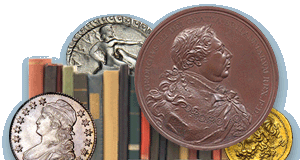
PREV ARTICLE
NEXT ARTICLE
FULL ISSUE
PREV FULL ISSUE
EARLY ILLUSTRATION OF A CELTIC MINTBob Van Arsdell writes: "I just published an article about an 1815 color illustration of a Celtic mint in Britain. The illustration has hand-aquatinted images of coins on a copper plate engraving. But that's not the must useful thing about the image. It may give authors some insight into using antiquarian books for numismatic research, and the kinds of evidence one uses to sort out problems with them." Thank you. Here's an excerpt - see the complete article online. Excellent analysis. -Editor This image deserves more attention than it's received. It shows an ancient British mint in operation – and it's in colour no less. It's been around since 1815.
The image appears as plate XIII in Meyrick and Smith's The Costume of the Orignial Inhabitatants of the British Islands. Usually, such an image would appear over and over in numismatic publications and everyone would immediately recognize it. One wonders why this one hasn't received wider appreciation. That it appeared in a costume book might offer some explanation. If it had appeared in Ruding's Annals of the Coinage of Britain instead, it might have become more widely known in numismatic circles. Few would go looking for a numismatic image in a costume book. ....But perhaps something more nefarius happened. Building an image – starting with nothing Meyrick (the author) and Smith (the illustrator) understood the task ahead of them. Meyrick, an expert on armour, led the project. The two men wanted to recreate an ancient mint accurately. More impressively, they described the methodology they used and were careful to cite sources. They sought images as close to the time of the mint as they could find to include in their illustration. The resulting illustration is a composite of genuine ancient images, using the information available in 1815. In only one instance were they forced to use an inspiration from modern times. No ancient source was available for the mint building. So for that they had to guess. They were bound to make mistakes – but pressed ahead anyway. However, they had no intention of dreaming things up. Disassembling the Image The image is made up of a general scene with two figures. Below, there are two coins. These four elements – scene, two figures, and coins at the bottom – must be assessed separately to appreciate Meyrick's accomplishment.
To read the complete article, see:
Wayne Homren, Editor The Numismatic Bibliomania Society is a non-profit organization promoting numismatic literature. See our web site at coinbooks.org. To submit items for publication in The E-Sylum, write to the Editor at this address: whomren@gmail.com To subscribe go to: Subscribe All Rights Reserved. NBS Home Page Contact the NBS webmaster 
|



